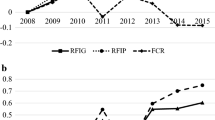Summary
Correlated responses in growth, body composition and efficiency were evaluated in lines of mice selected in the following ways: W+T oi , increased six-week body weight (WT6); W ° T +i , increased six-week tail length (TL6); W+T −i , increased WT6 and decreased TL6; W−T +i , decreased WT6 and increased TL6; M16, increased three-to six-week postweaning gain (PWG). Each of the first four selection treatments had two replicate lines (i = 1, 2) selected for 13 generations and the fifth treatment had one line selected for 30 generations. All lines were derived from a randombred ICR albino population which served as a control. Additional traits studied were three-week body weight and tail length, postweaning gain in tail length, percent body composition (ash, fat, moisture and protein) at six weeks of age, and three-to six-week feed consumption (CONS) and efficiency (EFF = PWG/CONS). Efficiency of body constituent gains (ash, fat, protein and caloric value) were determined by dividing each constituent by CONS. Relative to selection treatments, replicate variation in the array of traits was small and was primarily attributable to the effects of genetic drift; more frequent significant replicate differences among traits in W+T− were associated with a replicate difference in cumulative selection differentials. Selection for different criteria involving WT6 and TL6 did not change the allometric relationship between tail length and body weight in the three-to six-week age interval. The significant divergence between W+T ° and W °T+ and between W+T− and W−T+ was as expected for WT6 and TL6. Significant asymmetry of selection response between W+T− and W−T+ for WT6 and TL6 was attributed to maternal effects. In agreement with theory, antagonistic index selection generally yielded smaller genetic responses than single trait selection. Positive correlated responses in CONS and EFF were found for M16 and W+T °. Significant correlated changes in CONS (positive in W °T+ and negative in W−T+) were not accompanied by a significant change in EFF. In contrast, W+T− evinced an increased EFF and no change in CONS. Percent fat increased significantly in W+T ° and M16. For W+To, W+T− and M16, an increased energetic, fat and ash efficiency was observed, whereas M16 exhibited a positive increment in protein efficiency as well. Among selection treatment means, there were high positive correlations between WT6 and fat weight, protein weight, percent fat, CONS and EFF and a high negative correlation between WT6 and percent protein.
Similar content being viewed by others
Literature
Blaxter, K.L.: The effect of the dietary energy supply on growth. In: Growth and Development of Mammals, Ed. Lodge, G.A.; Lamming, G.E. London: Butterworths 1968
Eisen, E.J.: Population size and selection intensity effects on long-term selection response in mice. Genetics 79, 305–323 (1975)
Eisen, E.J.; Hanrahan, J.P.: Genetic drift and inbreeding depression measured from control populations of mice. Can. J. Genet. Cytol. 16, 91–104 (1974)
Eisen, E.J.; Leatherwood, J.M.: Effects of early pregnancy on growth, body compsition and efficiency in mice. J. Anim. Sci. 42, 52–62 (1976)
Falconer, D.S.: Selection for large and small size in mice. J. Genetics 51, 410–501 (1953)
Falconer, D.S.: Replicated selection for body weight in mice Genet. Res. 22, 291–321 (1973)
Fowler, R.E.: The growth and carcass composition of strains of mice selected for large and small body size. J. Agr. Sci. 51, 137–148 (1958)
Hanrahan, J.P.; Eisen, E.J.; Legates, J.E.: Effects of population size and selection intensity on short-term response to selection for postweaning gain in mice. Genetics 73, 513–530 (1973)
Kirk, R.E.: Experimental Design: Procedures for Behavioral Sciences. Belmont, Calif.: Brooks-Cole 1968
Martin, R.J.: Characterization of enzyme and metabolic patterns in mice selected for rapid postweaning growth rate. Growth 38, 53–59 (1974)
Priestley, G.C.; Robertson, M.S.M.: Protein and nucleic acid metabolism in organs from mice selected for larger and smaller body weight. Genet. Res. 22, 255–278 (1973)
Rutledge, J.J.; Robison, O.W.; Eisen, E.J.; Legates, J. E.: Dynamics of genetic and maternal effects in mice. J. Anim. Sci. 35, 911–918 (1972)
Rutledge, J.J.; Eisen, E.J.; Legates, J.E.: An experimental evaluation of genetic correlation. Genetics 75, 709–726 (1973)
Rutledge, J.J.; Eisen, E.J.; Legates, J.E.: Correlated responses in skeletal traits and replicate variation in selected lines of mice. Theoret. Appl. Genetics 45, 26–31 (1974)
Sutherland, T.M.; Biondini, P.E.; Ward, G.M.: Selection for growth rate, feed efficiency, and body composition in mice. Genetics 78, 525–540 (1974)
Tallis, G.M.: Sampling errors of genetic correlation coefficients calculated from analyses of variance and covariance. Aust. J. Stat. 1, 35–43 (1959)
Timon, V.M.; Eisen, E.J.: Comparison of growth curves of mice selected and unselected for postweaning gain. Theoret. Appl. Genetics 39, 345–351 (1969)
Timon, V.M.; Eisen, E.J.: Comparisons of ad libitum and restricted feeding of mice selected and unselected for postweaning gain. I. Growth, feed consumption, and feed efficiency. Genetics 64, 41–57 (1970)
Timon, V.M.; Eisen, E.J.; Leatherwood, J.M.: Comparisons of ad libitum and restricted feeding of mice selected and unselected for postweaning gain. II. Carcass composition and energetic efficiency. Genetics 65, 145–155 (1970)
White, J.M.; Legates, J.E.; Eisen, E.J.: Maternal effects among lines of mice selected for body weight. Genetics 60, 395–408 (1968)
Author information
Authors and Affiliations
Additional information
Communicated by H. Abplanalp
Paper No.4916 of the Journal Series of the North Carolina Agricultural Experiment Station, Raleigh, N.C. 27607. “The use of trade names in this publication does not imply endorsement by the North Carolina Agricultural Experiment Station of the products named, nor criticism of similar ones not mentioned.”
Rights and permissions
About this article
Cite this article
Eisen, E.J., Bandy, T. Correlated responses in growth and body composition of replicated single-trait and index selected lines of mice. Theor Appl Genet 49, 133–144 (1977). https://doi.org/10.1007/BF00281711
Received:
Published:
Issue Date:
DOI: https://doi.org/10.1007/BF00281711




